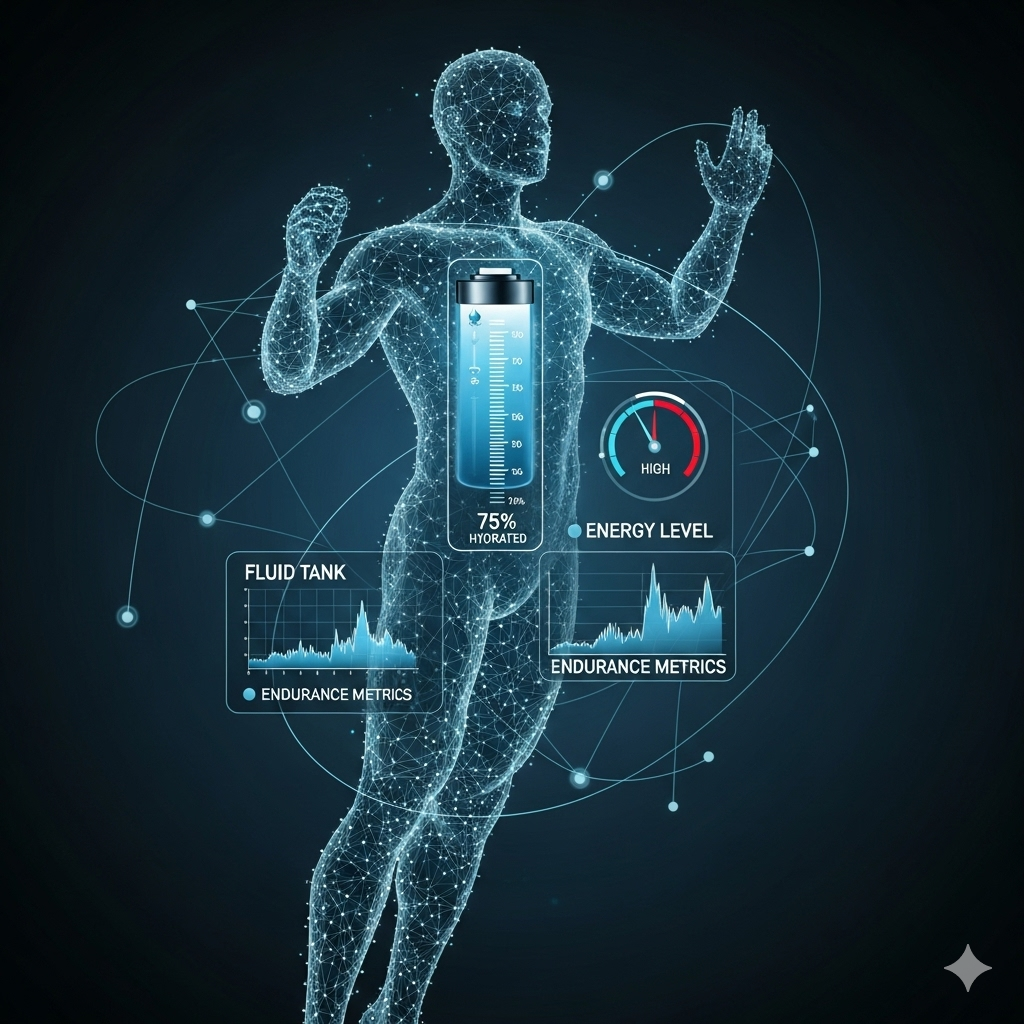In the world of fitness and athletic performance, we often focus on the big rocks: intense training, meticulous nutrition, and adequate sleep. While these are undoubtedly crucial, there’s a foundational element that underpins them all, yet is often overlooked or oversimplified: hydration. Water is the most abundant molecule in the human body, involved in virtually every physiological process. For athletes, optimal hydration is not just about quenching thirst; it’s a critical factor in endurance, energy, and overall performance. This blog post will delve into the science of hydration, exploring how you can biohack your water intake to unlock new levels of stamina and vitality.
Why Hydration is a Game-Changer for Athletes
Even slight dehydration can have a significant negative impact on athletic performance. A loss of just 2% of body weight through sweat can lead to a noticeable decrease in strength, endurance, and cognitive function [1]. Here’s why staying hydrated is so critical:
- Thermoregulation: During exercise, your body generates heat. Sweating is the primary mechanism for cooling down, but it also leads to fluid loss. Proper hydration is essential for maintaining a safe core body temperature and preventing heat-related illnesses.
- Nutrient Transport: Water is the primary medium for transporting nutrients, including glucose (your muscles’ main fuel source), to your cells. Dehydration can impair this process, leading to premature fatigue.
- Joint Lubrication: Water is a key component of synovial fluid, which lubricates your joints and allows for smooth, pain-free movement.
- Cognitive Function: The brain is highly sensitive to dehydration. Even mild dehydration can impair focus, decision-making, and reaction time—all of which are critical for athletic performance.
Biohacking Your Hydration: Beyond Just Drinking Water
While drinking water is the foundation of good hydration, a biohacker’s approach goes beyond simply sipping throughout the day. It involves a more strategic and personalized approach to fluid and electrolyte balance.
1. Understand Your Individual Needs
There’s no one-size-fits-all recommendation for water intake. Your individual needs will vary based on factors like your body size, activity level, climate, and sweat rate. A simple way to estimate your baseline needs is to drink half your body weight in ounces of water per day. However, this is just a starting point. A more precise method is to weigh yourself before and after a workout to determine your sweat rate. For every pound of weight lost, you should aim to replenish with 16-24 ounces of fluid.
2. The Crucial Role of Electrolytes
When you sweat, you lose not just water, but also essential electrolytes like sodium, potassium, and magnesium. These minerals are vital for nerve function, muscle contraction, and maintaining fluid balance. Simply drinking plain water during intense or prolonged exercise can lead to a dilution of electrolytes, a condition known as hyponatremia, which can be dangerous.
To biohack your electrolyte balance:
- Add a pinch of sea salt to your water: This is a simple and effective way to replenish sodium.
- Use a high-quality electrolyte supplement: Look for supplements that provide a balanced ratio of sodium, potassium, and magnesium, without excessive sugar.
- Consume electrolyte-rich foods: Bananas, avocados, and leafy greens are excellent sources of potassium.
3. The Concept of Structured Water
While the concept of “structured water” is a topic of ongoing scientific debate and is not universally accepted in mainstream science, some biohackers explore the idea that water can exist in different molecular arrangements, potentially influencing its biological properties. Proponents suggest that water found in natural springs or certain fruits and vegetables has a more organized, hexagonal structure (often referred to as EZ water or exclusion zone water) that is more readily absorbed and utilized by the body. While concrete scientific evidence is still limited, some biohackers experiment with methods to “structure” their water, such as:
- Vortexing: Stirring water vigorously to create a vortex.
- Adding Minerals: Using trace minerals or Himalayan pink salt to enhance water’s mineral content.
- Exposure to Natural Light/Magnets: Some believe exposure to natural light or magnetic fields can influence water’s structure.
It’s important to approach this concept with a critical mind and prioritize scientifically proven hydration strategies. However, for those interested in exploring the fringes of biohacking, structured water remains an area of interest.
4. Water Quality Matters
The quality of your water source can significantly impact your hydration and overall health. Tap water, while generally safe, can contain various contaminants like chlorine, fluoride, heavy metals, and pharmaceutical residues. Biohackers often prioritize filtering their water to remove these impurities.
- Filtered Water: Investing in a high-quality water filter (e.g., reverse osmosis, activated carbon, or gravity filters) can remove a wide range of contaminants, improving the taste and purity of your drinking water.
- Spring Water: Some biohackers prefer natural spring water, believing it to be a more pristine and mineral-rich source of hydration.
- Hydrogen Water: Research has shown that drinking hydrogen-rich water before exercising can mitigate the effects of fatigue and build endurance [2]. This is an emerging area of interest in the biohacking community.
Practical Biohacking Tips for Optimal Hydration
Integrating these principles into your daily routine can significantly enhance your hydration status and, consequently, your athletic performance.
- Start Your Day Hydrated: Drink a large glass of water (with a pinch of sea salt or electrolytes) immediately upon waking. This rehydrates your body after hours of sleep and kickstarts your metabolism.
- Hydrate Consistently Throughout the Day: Don’t wait until you’re thirsty. Thirst is already a sign of mild dehydration. Keep a water bottle with you and sip regularly.
- Pre- and Intra-Workout Hydration: Consume 16-20 ounces of water 2-3 hours before exercise, and another 8-10 ounces 20-30 minutes before. During exercise, aim for 4-8 ounces every 15-20 minutes, especially during intense or prolonged sessions, and consider adding electrolytes.
- Post-Workout Replenishment: Immediately after your workout, focus on replenishing lost fluids and electrolytes. Weigh yourself before and after to gauge fluid loss and aim to drink 16-24 ounces for every pound lost.
- Monitor Urine Color: A simple, yet effective, indicator of hydration status. Aim for a pale yellow color. Darker urine indicates dehydration.
- Track with Technology: Utilize smart water bottles or hydration tracking apps to monitor your intake and receive reminders.
Conclusion: The Unsung Hero of Performance
Hydration, often an unsung hero, is a fundamental pillar of athletic performance and overall well-being. By adopting a biohacker’s mindset, you can move beyond conventional wisdom and meticulously optimize your water intake, electrolyte balance, and even water quality. This proactive approach ensures that your body’s most abundant resource is working optimally to support every physiological process, from energy production and nutrient transport to thermoregulation and cognitive function. By prioritizing and strategically biohacking your hydration, you’re not just drinking water; you’re unlocking enhanced endurance, sustained energy, and a more resilient, high-performing version of yourself. Make hydration your competitive edge, and watch your fitness journey transform.
References:
[1] Hydration and athletic performance: The science behind peak output. Science.drinklmnt.com. Available at: https://science.drinklmnt.com/electrolytes/hydration-and-athletic-performance
[2] Hydrogen Water: Extra Healthy or a Hoax?—A Systematic Review. Pmc.ncbi.nlm.nih.gov. Available at: https://pmc.ncbi.nlm.nih.gov/articles/PMC10816294/


